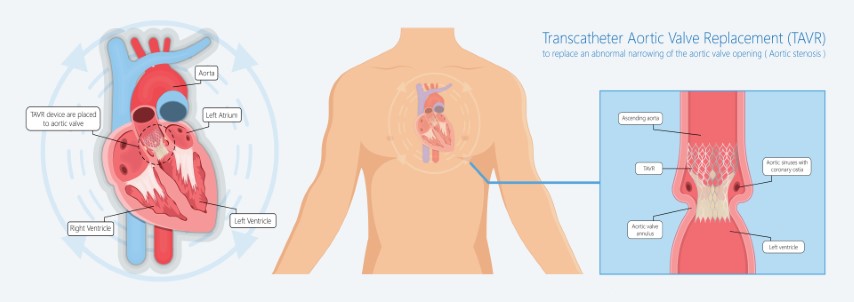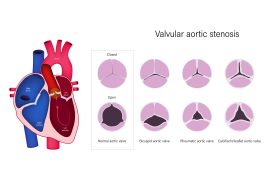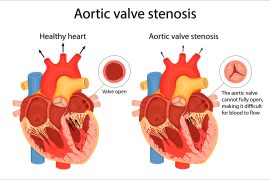As we move ahead in life, it’s not just our lifestyles that change – the amount of pressure we put on our hearts increases as well. The increased strain at times gives way to various heart diseases, one of the most common ones among them being Aortic Valve Stenosis.
Aortic Valve Stenosis is a condition of the heart where one of the four valves i.e. the aortic valve is narrowed and fails to open properly. This causes various cardiovascular diseases due to inadequate blood supply and pressure on the aortic valve. To treat the said condition, a procedure called Transcatheter Aortic Valve Replacement (TAVR) is performed.
What is a TAVR Procedure?
TAVR is a minimally invasive medical procedure that is used to treat Aortic Stenosis (AS). Before TAVR, Surgical Aortic Valve Replacement (SAVR) or open-heart surgery was the only way to cure aortic stenosis, but the procedure also led to several other complications among patients. But TAVR has made this procedure Less painful, less scarring with a faster recovery.
As this approach avoids surgically opening the chest or making an incision on the heart, TAVR is a safer option for high-risk patients. Before deciding on undergoing TAVR, you must consult your cardiac surgeon and specialists to determine if the procedure is beneficial for you.
Why does Aortic Valve Stenosis need to be treated?
A few of the complications that arise with Aortic Stenosis are chest pain, extreme fatigue, fainting, gasping, and swelling on the leg. It may also lead to cardiac arrest and heart failure. Hence, it must be treated immediately.
What has involved in the Transcatheter Aortic Valve Replacement (TAVR) procedure?
A catheter, which is a small, flexible tube is used to place a new valve in the heart. The doctor will make a small incision in a blood vessel in your leg or the chest wall. Once done, the doctor uses advanced imaging techniques to guide the catheter to your heart and into the aortic valve and position it properly.
What are the different types of TAVR Procedures?
While TAVR is essentially the placing of a valve via a catheter, the procedure varies from case to case. These include –
Transfemoral TAVR: A small opening is made to access an artery in the groin area at the top of the leg.
Transapical TAVR: An incision is made in the chest wall, between the left ribs, through which the catheter is inserted.
Transaortic TAVR: A small opening is made on top of the breast bone, through which the catheter is directly inserted into the aorta.
Transcaval TAVR: An incision is made in a large vein in the groin area, through which the catheter can be inserted, from which it goes through the vena cava to the abdominal aorta, and into the aortic valve.



Why can’t all Patients with Aortic Valve Disease opt for a Transcatheter Aortic Valve Replacement (TAVR) procedure?
One can opt for TAVR if they have Aortic Stenosis that leads to other symptoms and complications. They can usually opt for TAVR if they are at a higher risk of experiencing complications from open-heart surgery. Open-heart surgery is also risky if one has a kidney or lung disease. Though TAVR might be preferred due to its minimally invasive nature, one must be thoroughly evaluated before undergoing a TAVR. Patients with extremely high risk to moderate risk conditions are usually the ideal candidates for TAVR. Similarly, patients with active endocarditis infection or a similar aneurysm also cannot opt for a TAVR. Bicuspid patients who don’t prefer an open-heart surgery can seek a thorough evaluation with the TAVR team to discuss the risk factors and benefits and to also seek other treatment options. Also, patients in their 50s and 60s are refrained from opting for TAVR due to limited data present for the durability of bioprosthetic heart valves.



Are there any risks involved in a TAVR procedure?
Every medical procedure comes with some risks and the same applies to TAVR too. Hence it is important to have an expert opinion before undergoing any surgery for Aortic Valve diseases. Some of the major risks involved in TAVR are as follows:
Bleeding: Though the procedure is minimally invasive, it involves inserting a catheter in your leg, which may lead to internal bleeding.
Complications in the blood vessels: Injuries are caused due to vascular access which in turn, can lead to tissue malperfusion. Passing catheters through the arteries can also damage them.
Replacement valve: It might also lead to problems with the replacement valve such as blood leaks around the new valve or the valve slipping out of place.
Arrhythmia: It might lead to irregular heart rhythms, which would require pacemaker implantation.
Stroke: A small percentage of patients undergoing TAVR have complained of stroke, either during the procedure or after it.
Damage to the kidney: The dye that is used for imaging can affect the kidneys, leading to kidney damage. But this complication is usually reversible.
Heart Attack: A minimal percentage of patients have also had heart attacks during the procedure.
Infection: Passing catheters through the arteries can also lead to infections, but they are usually treatable.
Death: While TAVR is usually effective, there is a very low possibility that the patient cannot survive the procedure.
When it comes to heart health, it is important to weigh the pros and cons properly to avoid health issues in the future. As technology advances, the risks associated with it grows. But proper medical care and procedure surely avert all the risks and helps people to lead a normal life after TAVR or any surgery. All you need to do is take proper precautions and follow the advice of your doctor in the pre and post phases of the surgery to keep your heart healthy in the long run.




